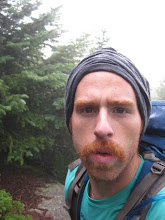 |
| Summit of Blackhead Mountain in the Catskills over the weekend. Beautiful but treacherous, icy scrambles lined the descent. |
I went to the woods because I wished to live deliberately, to front only the essential facts of life, and see if I could not learn what it had to teach, and not, when I came to die, discover that I had not lived. - H.D. Thoreau
After weeks (months?) of somewhat aimless drifting and low output, I'm up to 7 mile daily runs. I'll build to 75-80 miles/week over the next few months. Despite an aching left ankle/arch, I can feel the past months of training haven't left my legs, even though I took nearly a month off. Although I've been slowly building a base for almost 3 weeks, tonight's run represented something new for me: a return to purposeful and disciplined living. A discipline that extends beyond running but finds its expression most succinctly in it.
Tonight also marked the first sub-10 degree run of the winter. The familiar sensation of a frozen mustache, numb fingers and toes, and the bemused stares of neighbors suggest that the winter running season has arrived. Where 3 months earlier the streets were crowded with each and every variety of runner, now the running community is pared down to the passionate and determined. There is a certain thrill to stepping out into freezing, blustering winds, and finding yourself alone in the streets. Block after block, turn after turn, with nobody in sight; the solitude of running is pronounced on cold winter nights.
Tonight also marked the first sub-10 degree run of the winter. The familiar sensation of a frozen mustache, numb fingers and toes, and the bemused stares of neighbors suggest that the winter running season has arrived. Where 3 months earlier the streets were crowded with each and every variety of runner, now the running community is pared down to the passionate and determined. There is a certain thrill to stepping out into freezing, blustering winds, and finding yourself alone in the streets. Block after block, turn after turn, with nobody in sight; the solitude of running is pronounced on cold winter nights.
So imagine the curiosity when you see a blinking light in the far off distance and you realize that what you see is not a car or a bike, but... another runner! And your pace increases almost imperceptibly as you anticipate the meeting. And if it's an especially cold night you share a smile and a nod as you pass. I'm not sure what the nod means, but it's a feeling of communion. In that brief and silent moment, you'll share more in common with a stranger than you will with most people you encounter the rest of the week. And you reflect on that for a minute, two minutes, three minutes.
And then, seamlessly, thoughts evaporate and your attention flows back into the rhythm of the run.






































